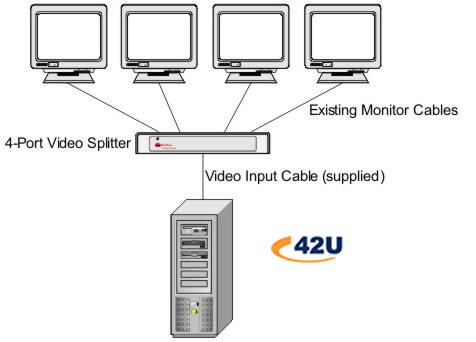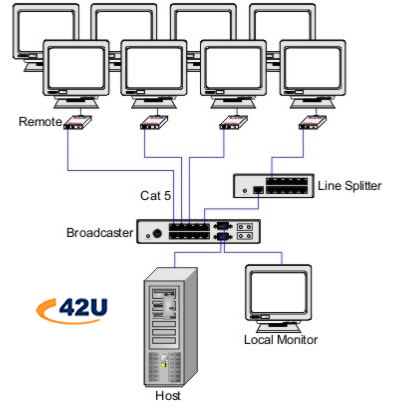Video Splitters-The Basics
Video Splitter Products Let You Share Your Computer or Video Output
A video splitter is a device that takes one signal from a video source and replicates it over multiple monitors. The number of times that a video splitter divides the signal varies; video splitters currently on the market provide divisions for as few as two ports or as many as hundreds of ports.
There are two main types of video splitters: standard VGA video splitters and Cat 5 video splitters.
Standard VGA Video Splitters:
Standard VGA video splitters allow a single VGA video source to simultaneously drive 2, 4, 8, or 16 SVGA, VGA, XGA, and Multisync monitors. Standard VGA video splitters use coaxial-style VGA cables to connect the target video source to multiple monitor feeds.
Applications
Standard VGA video splitters can be effectively used in settings that require images to be replicated on several monitors. They are often used in classrooms, at tradeshow venues, in point-of-sale displays at retail stores, and in airports.
Resolution
Supported resolution is often as high as 1900×1200, assuming that the split monitors are not more than 20-30 feet away from the video source. If a monitor is extended past 20-30 feet, video degradation and ghosting may result. To mitigate this problem, some video splitters include a built-in signal booster, which allows the video signal to be extended up to 200 feet over a standard VGA cable.

Cat 5 Video Splitters:
A Cat 5-based video splitter differs from a standard VGA video splitter mainly by the type of cable that is used to connect the target video source to the multiple monitor feeds. While standard video splitters use coaxial-style VGA cables, Cat 5 video splitters implement thin Cat 5 cabling, which reduces the cabling nightmare often presented by standard video splitters. In addition, some Cat 5 video splitters (for example, Minicom’s VDS product line) allow a user to darken all remote monitors while administrative changes are being made. Cat 5 splitters allow multiple targets to be extended up to 820 ft from the video source.
Applications
Cat 5 video splitters can be used in the same settings as standard VGA video splitters and are often better suited for applications where distances are greater and more monitors are required.
Resolution
Minicom’s Cat 5 Video Display System can transmit hundreds of real-time remote video displays up to 1600×1200 at 75 Hz. Minicom’s 2 and 4-port Cat 5 UTP video splitters support high-resolution video at 1280×1024 at 75 Hz.





